Michael Margaliot
MMiMMMMiMiMiMiMiMMiMiMMiMiMiMiMiMMiMiMMiMiMiMMMMMiMiMiMMiMiMiMiMMiiMiMMiMiiMiMMiiMMiMiMMMMMiMiiMiMiiMMiiMM cchchchchchchchchcchchchchchchchchchchchchchchchchchchchchchchhchchchchccchhhhhhhccchhhcchchaeaeaeaeaeaeaeaeaeaeaeaeaeaeaeaeaeaeaeaaaeaaaeaaeaaeaeaeaeeaeaeaeaaeael l l l l ll ll lll lllllllllllllllllllllll MaMaMaMaMaMaMaMaMaMaMaMaMaMaMaMaMaMaMaMaMaMaMMaMaMaMaMMMMaMaMMaMMaMMaMaMMaMaMMMMaMaMMMaMMMargrgrgrgrgrgrgrggrgrgrgrgrgrgrgrgrgrgrgrgrgrgrgrgrgggrgrgrgrgrgrggrgrgrgrrggggggalalalalalalalalalalalalallalalalalalalallalalallalaalallalalaaaaala ioioioioioioioioioioioioiiooioioioioioioioioioioiioioiioioioiooioiooiiotttttttttttttttttttttttttttttt
Tel Aviv University, Israel
TeTelTelTelTelTelTelTelTeTelTelTelTelTelTelTeTelTelTTTelTelTelT lTelTelTelTellTeTeTTellelTeTelTelTeTelTelTelTTTeelTeelTTelTTTelelelTeeee A AvAAvAA Av Av Av Av Av Av AvAvAv AvAvA Av AvAvAAvAvAvAv Av Av AvAAAvAvAvvAAvAv AvA AAAvAAA iviviv iv iv iviv iviv iv iv ivvv iviviv iv iviviviv iviviiviv vivivivivvviivvii UniUniUniUniUniUniUniUniUniUnUnUniUUniUniUniUniUniUniUniUniUnnUniUniUniUniUUniUniUniUniUUUnUniUniiUUniUnUUUUnUUnUUnUnnUUniiUUnUnUnn verververververververververververververveveververververvevververereververererververeverveverererrveervvvvvvevvve sitsitsitsitsitsitsitsitsitsitsitsitsitsitsitsitsitsitsitsitsititsitisitsitsisssisittsitsittsittitiiity, y,y, y, y, y, y, y, y, yy, yy, y, yy, yyyy, y, y,y,y, y,y,y,y, y, y, y, y, yy,y,yy,yyy,y,yyy IsrIsrIsrIsrIsrIsrIsrIsrIssrIsrIsrssrIsrIsIsIsrIIsrIsrIIIsrIIIsrIsrIsrsrIsIsrIsrIsrsrIsIsrrs aelaelaeaelaelaelaelaelaelaelaelaelaelaelaelaeelaelelaelaeaeaelaelaellllaelaellaelaaaelaelaelaeleellaellelaaeleeaela
Adaptive Dynamic
Programming: An Introduction
Fei-Yue Wang, Chinese Academy of Sciences,
CHINA and University of Arizona, USA
Huaguang Zhang, Northeastern University, CHINA
and Derong Liu, Chinese Academy of Sciences, CHINA
Digital Object Identifier 10.1109/MCI.2009.932261
©STOCKBYTE
Abstract: In this article, we introduce some recent research trends
within the field of adaptive/approximate dynamic programming
(ADP), including the variations on the structure of ADP
schemes, the development of ADP algorithms and applications
of ADP schemes. For ADP algorithms, the point of focus is that
iterative algorithms of ADP can be sorted into two classes: one
class is the iterative algorithm with initial stable policy; the other
is the one without the requirement of initial stable policy. It is
generally believed that the latter one has less computation at the
cost of missing the guarantee of system stability during iteration
process. In addition, many recent papers have provided conver-
gence analysis associated with the algorithms developed. Fur-
thermore, we point out some topics for future studies.
1556-603X/09/$25.00©2009IEEE
MAY 2009 | IEEE COMPUTATIONAL INTELLIGENCE MAGAZINE 39
�
Introduction
A
s is well known, there are many methods for designing
stable control for nonlinear systems. However, stability
is only a bare minimum requirement in a system
design. Ensuring optimality guarantees the stability of
the nonlinear system. Dynamic programming is a very useful
tool in solving optimization and optimal control problems by
employing the principle of optimality. In [16], the principle of
optimality is expressed as: “An optimal policy has the property
that whatever the initial state and initial decision are, the
remaining decisions must constitute an optimal policy with
regard to the state resulting from the first decision.” There are
several spectrums about the dynamic programming. One can
consider discrete-time systems or continuous-time systems, lin-
ear systems or nonlinear systems, time-invariant systems or
time-varying systems, deterministic systems or stochastic sys-
tems, etc.
We first take a look at nonlinear discrete-time (time-
varying) dynamical (deterministic) systems. Time-varying non-
linear systems cover most of the application areas and
discrete-time is the basic consideration for digital computation.
Suppose that one is given a discrete-time nonlinear (time-
varying) dynamical system
x1k 1 12 5 F 31x1k2, u1k2, k4, k 5 0, 1, c
(1)
where x [ Rn represents the state vector of the system and
u [ Rm denotes the control action and F is the system func-
tion. Suppose that one associates with this system the perfor-
mance index (or cost)
J 3x1i2, i4 5 a`
g k2iU 3x1k2, u1k2, k4
(2)
k5i
where U is called the utility function and g is the discount
factor with 0 , g # 1. Note that the function J is dependent
on the initial time i and the initial state x( i ), and it is referred to
as the cost-to-go of state x( i ). The objective of dynamic pro-
gramming problem is to choose a control sequence
u(k), k 5 i, i 1 1, c, so that the function J (i.e., the cost) in
(2) is minimized. According to Bellman, the optimal cost from
time k is equal to
J *1x1k22 5 min
EU 1x1k2, u1k22 1 g J *1x1k 1 122F. (3)
u1k2
The optimal control u *1k2 at time k is the u1k2 which achieves
EU 1x1k2, u1k22 1 gJ *1x1k 1 122F. (4)
u*1k2 5 arg min
u1k2
this minimum, i.e.,
Equation (3) is the principle of optimality for discrete-time
systems. Its importance lies in the fact that it allows one to
optimize over only one control vector at a time by working
backward in time.
In nonlinear continuous-time case, the system can be
described by
40 IEEE COMPUTATIONAL INTELLIGENCE MAGAZINE | MAY 2009
The cost in this case is defined as
For continuous-time systems, Bellman’s principle of opti-
mality can be applied, too. The optimal cost J *(x0) 5 min
J (x0, u(t )) will satisfy the Hamilton-Jacobi-Bellman Equation
'J *1x1t22
't
t
x
#1t2 5 F 3x1t2, u1t2, t4, t $ t0.
J 1x1t22 53 `
U1x1 t2, u1 t22dt.
bU 1x1t2, u1t2, t2 1a'J *1x1t22
'x1t2
3 F 1x1t2, u1t2, t2r
5 U1x1t2, u*1t2, t2 1a'J *1x1t22
b T
'x1t2
3 F 1x1t2, u*1t2, t2.
5 min
u[U
b T
(5)
(6)
(7)
2
Equations (3) and (7) are called the optimality equations
of dynamic programming which are the basis for implemen-
tation of dynamic programming. In the above, if the func-
tion F in (1) or (5) and the cost function J in (2) or (6) are
known, the solution of u(k ) becomes a simple optimization
problem. If the system is modeled by linear dynamics and
the cost function to be minimized is quadratic in the state
and control, then the optimal control is a linear feedback of
the states, where the gains are obtained by solving a standard
Riccati equation [47]. On the other hand, if the system is
modeled by nonlinear dynamics or the cost function is non-
quadratic, the optimal state feedback control will depend
upon solutions to the Hamilton-Jacobi-Bellman (HJB)
equation [48] which is generally a nonlinear partial differ-
ential equation or difference equation. However, it is often
computationally untenable to run true dynamic program-
ming due to the backward numerical process required for its
solutions, i.e., as a result of the well-known “curse of dimen-
sionality” [16], [28]. In [69], three curses are displayed in
resource management and control problems to show the
cost function J, which is the theoretical solution of the
Hamilton-Jacobi- Bellman equation, is very difficult to
obtain, except for systems satisfying some very good condi-
tions. Over the years, progress has been made to circumvent
the “curse of dimensionality” by building a system, called
“critic”, to approximate the cost function in dynamic pro-
gramming (cf. [10], [60], [61], [63], [70], [78], [92], [94],
[95]). The idea is to approximate dynamic programming
solutions by using a function approximation structure such
as neural networks to approximate the cost function.
The Basic Structures of ADP
In recent years, adaptive/approximate dynamic programming
(ADP) has gained much attention from many researchers in order
to obtain approximate solutions of the HJB equation,
�
cf. [2], [3], [5], [8], [11]–[13], [21], [22], [25], [30], [31], [34],
[35], [40], [46], [49], [52], [54], [55], [63], [70], [76], [80],
[83], [95], [96], [99], [100]. In 1977, Werbos [91] introduced an
approach for ADP that was later called adaptive critic designs
(ACDs). ACDs were proposed in [91], [94], [97] as a way for
solving dynamic programming problems forward-in-time. In the
literature, there are several synonyms used for “Adaptive Critic
Designs” [10], [24], [39], [43], [54], [70], [71], [87], including
“Approximate Dynamic Programming” [69], [82], [95], “Asymp-
totic Dynamic Programming” [75], “Adaptive Dynamic Pro-
gramming” [63], [64], “Heuristic Dynamic Programming” [46],
[93], “Neuro-Dynamic Programming” [17], “Neural Dynamic
Programming” [82], [101], and “Reinforcement Learning” [84].
Bertsekas and Tsitsiklis gave an overview of the neuro-
dynamic programming in their book [17]. They provided the
background, gave a detailed introduction to dynamic program-
ming, discussed the neural network architectures and methods for
training them, and developed general convergence theorems for
stochastic approximation methods as the foundation for analysis of
various neuro-dynamic programming algorithms. They provided
the core neuro-dynamic programming methodology, including
many mathematical results and methodological insights. They sug-
gested many useful methodologies for applications to neuro-
dynamic programming, like Monte Carlo simulation, on-line and
off-line temporal difference methods, Q-learning algorithm, opti-
mistic policy iteration methods, Bellman error methods, approxi-
mate linear programming, approximate dynamic programming
with cost-to-go function, etc. A particularly impressive success that
greatly motivated subsequent research, was the development of a
backgammon playing program by Tesauro [85]. Here a neural
network was trained to approximate the optimal cost-to-go func-
tion of the game of backgammon by using simulation, that is, by
letting the program play against itself. Unlike chess programs, this
program did not use lookahead of many steps, so its success can
be attributed primarily to the use of a properly trained approxi-
mation of the optimal cost-to-go function.
To implement the ADP algorithm, Werbos [95] proposed a
means to get around this numerical complexity by using
“approximate dynamic programming” formulations. His meth-
ods approximate the original problem with
a discrete formulation. Solution to the
ADP formulation is obtained through neu-
ral network based adaptive critic approach.
The main idea of ADP is shown in Fig. 1.
He proposed two basic versions which
are heuristic dynamic programming (HDP)
and dual heuristic programming (DHP).
Reward/Penalty
Critic
Performance
Index Function
Action
Control
Dynamic
System
Agent
State
FIGURE 1 Learn from the environment.
samples from the instantaneous utility function U, while models
of the environment and the instantaneous reward are needed to
find the cost function corresponding to the optimal policy.
In HDP, the output of the critic network is J^, which is the
estimate of J in equation (2). This is done by minimizing the
following error measure over time
3 J^1k2 2 U1k2 2 gJ^1k 1 1242, (8)
4 and WC represents the
7Eh7 5a
where J^(k) 5 J^3x(k), u(k), k, WC
1k2 5
J^1k2 5 U1k2 1 gJ^1k 1 12
parameters of the critic network. When Eh 5 0 for all k, (8)
implies that
a
k
1
2
(9)
Eh
k
and
J^(k) 5 a`
i5k
g i2kU( i ) which is the same as (2).
Dual Heuristic Programming (DHP)
Dual heuristic programming is a method for estimating the
gradient of the cost function, rather than J itself. To do this,
a function is needed to describe the gradient of the instanta-
neous cost function with respect to the state of the system. In
J(x(k))›
Critic
Network
Heuristic Dynamic Programming (HDP)
HDP is the most basic and widely applied
structure of ADP [13], [38], [72], [79], [90],
[93], [104], [106]. The structure of HDP is
shown in Fig. 2. HDP is a method for esti-
mating the cost function. Estimating the cost
function for a given policy only requires
u(k)
x(k)
Action
Network
Model
Network
x(k + 1)
Critic
Network
›
J(x(k + 1))
γ
U(k)
FIGURE 2 The HDP structure.
MAY 2009 | IEEE COMPUTATIONAL INTELLIGENCE MAGAZINE 41
�
the DHP structure, the action network remains the same as the
one for HDP, but for the second network, which is called the
critic network, with the costate as its output and the state vari-
ables as its inputs.
over time
a
k
1
2
The critic network’s training is more complicated than that
in HDP since we need to take into account all relevant path-
ways of backpropagation.
1k2 5
This is done by minimizing the following error measure
'J^1k 1 12
c 'J^1k2
'U1k2
7ED7 5 a
d 2
'x1k2
'x1k2 2 g
'x1k2 2
where 'J^1k2 /'x1k2 5 'J^3x1k2, u1k2, k, WC
4/'x1k2 and WC
'J1k 1 12
'x1k2
represents theparameters of the critic network. When Eh 5 0
for all k, (10) implies that
'U1k2
'x1k2 1 g
'J^1k2
'x1k2 5
,
(10)
.
(11)
ED
k
Theoretical Developments
In [82], Si et al summarizes the cross-disciplinary theoretical
developments of ADP and overviews DP and ADP; and dis-
cusses their relations to artificial intelligence, approximation
theory, control theory, operations research, and statistics.
In [69], Powell shows how ADP, when coupled with math-
ematical programming, can solve (approximately) deterministic
or stochastic optimization problems that are far larger than any-
thing that could be solved using existing techniques and shows
the improvement directions of ADP.
The Development of Structures
In [95], Werbos further gave two other versions called “action-
dependent critics,” namely, ADHDP (also known as Q-learning
[89]) and ADDHP. In the two ADP structures, the control is
also the input of the critic networks. In 1997, Prokhorov and
Wunsch [70] presented more algorithms according to ACDs.
∂J(x(k))›
∂x(k)
Critic
Network
›
∂J(x(k + 1))
∂x(k + 1)
γ
u(k)
x(k)
Action
Network
Model
Network
x(k + 1)
Critic
Network
FIGURE 3 The DHP structure.
42 IEEE COMPUTATIONAL INTELLIGENCE MAGAZINE | MAY 2009
They discussed the design families of HDP, DHP, and global-
ized dual heuristic programming (GDHP). They suggested
some new improvements to the original GDHP design. They
promised to be useful for many engineering applications in the
areas of optimization and optimal control. Based on one of
these modifications, they present a unified approach to all
ACDs. This leads to a generalized training procedure for ACDs.
In [26], a realization of ADHDP was suggested: a least squares
support vector machine (SVM) regressor has been used for
generating the control actions, while an SVM-based tree-type
neural network (NN) is used as the critic. The GDHP or
ADGDHP structure minimizes the error with respect to both
the cost and its derivatives. While it is more complex to do this
simultaneously, the resulting behavior is expected to be superi-
or. So in [102], GDHP serves as a reconfigurable controller to
deal with both abrupt and incipient changes in the plant
dynamics due to faults. A novel fault tolerant control (FTC)
supervisor is combined with GDHP for the purpose of
improving the performance of GDHP for fault tolerant control.
When the plant is affected by a known abrupt fault, the new
initial conditions of GDHP are loaded from dynamic model
bank (DMB). On the other hand, if the fault is incipient, the
reconfigurable controller maintains performance by continu-
ously modifying itself without supervisor intervention. It is
noted that the training of three networks used to implement
the GDHP is in an online fashion by utilizing two distinct net-
works to implement the critic. The first critic network is
trained at every iterations while the second one is updated with
a copy of the first one at a given period of iterations.
All the ADP structures can realize the same function that is
to obtain the optimal control policy while the computation
precision and running time are different from each other. Gen-
erally speaking, the computation burden of HDP is low but the
computation precision is also low; while GDHP has better pre-
cision but the computation process will take longer time and
the detailed comparison can be seen in [70].
In [30], [33] and [83], the schematic of direct heuristic
dynamic programming is developed. Using the approach of
[83], the model network in Fig. 1 is not needed anymore.
Reference [101] makes significant contri-
butions to model-free adaptive critic
designs. Several practical examples are
included in [101] for demonstration
which include single inverted pendulum
and triple inverted pendulum. A rein-
forcement learning-based controller
design for nonlinear discrete-time systems
with input constraints is presented by [36],
where the nonlinear tracking control is
implemented with filtered tracking error
using direct HDP designs. Similar works
also see [37]. Reference [54] is also about
model-free adaptive critic designs. Two
approaches for the training of critic net-
work are provided in [54]: A forward-in-time
∂U(k)
∂x(k)
�
approach and a backward-in-time approach.
Fig. 4 shows the diagram of forward-in-
time approach. In this approach, we view
J^(k) in (8) as the output of the critic net-
wo r k t o b e t r a i n e d a n d c h o o s e
U(k) 1 gJ^(k 1 1) as the training target.
Note that J^(k) and J^(k 1 1) are obtained
using state variables at different time instances. Fig. 5 shows
the diagram of backward-in-time approach. In this approach,
we view J^(k 1 1) in (8) as the output of the critic network to
be trained and choose ( J^(k) 2 U(k))/g as the training target.
The training ap proach of [101] can be considered as a back-
ward-in-time ap proach. In Fig. 4 and Fig. 5, x(k 1 1) is the
output of the model network.
An improvement and modification to the two network archi-
tecture, which is called the “single network adaptive critic
(SNAC)” was presented in [65], [66]. This approach eliminates
the action network. As a consequence, the SNAC architecture
offers three potential advantages: a simpler architecture, lesser
computational load (about half of the dual network algorithms),
and no approximate error due to the fact that the action network
is eliminated. The SNAC approach is applicable to a wide class of
nonlinear systems where the optimal control (stationary) equa-
tion can be explicitly expressed in terms of the state and the
costate variables. Most of the problems in aerospace, automobile,
robotics, and other engineering disciplines can be characterized
by the nonlinear control-affine equations that yield such a rela-
tion. SNAC-based controllers yield excellent tracking perfor-
mances in applications to microelectronic mechanical systems,
chemical reactor, and high-speed reentry problems. Padhi et al.
[65] have proved that for linear systems (where the mapping
between the costate at stage k 1 1 and the state at stage k is lin-
ear), the solution obtained by the algorithm based on the SNAC
structure converges to the solution of discrete Riccati equation.
Algorithms and Convergence Analysis
The exact solution of the HJB equation is generally impossible
to obtain for nonlinear systems. To overcome the difficulty in
solving the HJB equation, recursive methods are employed to
obtain the solution of HJB equation indirectly. In 1983, Barto
et al [12] developed a neural computation-based adaptive critic
learning method. They divides the state space into boxes and
stores learned information for each box. The algorithm works
well but the number of boxes can be very large for a complicated
system. In 1991, Lin and Kim [51] integrate the cerebellar model
articulation controller technique [1] with the box-based scheme.
Large state space is mapped into a smaller physical memory space.
With the distributed information storage, there is no need to
reserve memory for useless boxes; this makes the structure appli-
cable to problems of larger size. Kleinman [42] pointed out that
the solution of the Riccati equation can be obtained by succes-
sively solving a sequence of Lyapunov equations, which is linear
with respect to the cost function of the system, and thus, it is eas-
ier to solve than a Riccati equation, which is nonlinear with
respect to the cost function. Saridis and Lee [77] extended this
All the ADP structures can realize the same function
that is to obtain the optimal control policy while the
computation precision and running time are different
from each other.
›
J(k)
Eh(k)
U(k)
γ
›
J(k + 1)
Critic Network
Critic Network
x(t)
x(t + 1)
FIGURE 4 Forward-in-time approach.
idea to the case of nonlinear continuous-time systems where a
recursive method is used to obtain the optimal control of contin-
uous system by successively solving the generalized Hamilton–
Jacobi–Bellman (GHJB) equation, and then, updating the control
action if an admissible initial control is given.
Although the GHJB equation is linear and easier to solve than
HJB equation, no general solution for GHJB is demonstrated.
Therefore, successful application of the successive approximation
method was limited until the novel work of Beard et al. [15]
where they used a Galerkin spectral approximation method at
each iteration to find approximate solutions to the GHJB equa-
tions. And then Beard and Saridis [14] employed a series of poly-
nomial functions as basic functions to solve the approximate
GHJB equation in continuous time but this method requires the
computation of a large number of integrals and it is not obvious
how to handle explicit constraints on the controls. In [79], the
γ –1
U(k)
›
J(k+1)
Eh(k)
›
J(k)
Critic Network
Critic Network
x(k + 1)
x(k)
FIGURE 5 Backward-in-time approach.
MAY 2009 | IEEE COMPUTATIONAL INTELLIGENCE MAGAZINE 43
�
Equations (3) and (7) are called the optimality
equations of dynamic programming which are the
basis for implementation of dynamic programming.
method, two action networks and one critic net-
work are used that are adaptively tuned in forward
time using adaptive critic methods without the
system model information. The convergence anal-
ysis is also given to guarantee the cost function to
reach the saddle point of the game.
HJB equations are motivated and proven on time scales. The
authors connected the calculus of time scales and stochastic con-
trol via ADP algorithm and further pointed out three significant
directions for the investigation of ADP on time scales. Park [68]
employed interpolating wavelets as the basic functions. On the
other hand, Lewis and Abu-Khalaf presented how to formulate
the associated Hamilton–Jacobi–Isaac (HJI) equation using special
nonquadratic supply rates to obtain the nonlinear state feedback
control in [9]. Next, the fixed-final-time-constrained optimal
control of nonlinear systems is studied in [22], [23] based on the
neural network solution of the GHJB equation. In order to
enhance learning speed and final performance, Wiering and Has-
selt combined multiple different reinforcement learning algo-
rithms to design and implement four different ensemble methods
in [98]. In [41], a new algorithm for the closed loop parallel opti-
mal control of weakly coupled nonlinear systems is developed
using the successive Galerkin approximation. In [45], the author
inspired researchers to develop the experience-based approach
which selected a controller that is appropriate to the current situ-
ation from a repository of existing controller solutions.
Although many papers have discussed the GHJB method
for continuous-time systems, there is very minimal work avail-
able on the GHJB method for discrete-time nonlinear systems.
Discrete-time version of the approximate GHJB-equation-
based control is important since all the controllers are typically
implemented by using embedded digital hardware. In [21] a
successive approximation method using GHJB equation is pro-
posed to solve the near-optimal control problem for affine
nonlinear discrete-time systems, which requires small perturba-
tion assumption and an initially stable policy. The theory of
GHJB in discrete-time has also been applied to the linear dis-
crete-time case which indicates that the optimal control is
nothing but the solution of the standard Riccati equation.
On the other hand, in [19], Bradtke et al. implemented a
Q-learning policy iteration method for the discrete-time linear
quadratic optimal control problem which required an initial
stable policy. Furthermore, Landelius [44] applied HDP, DHP,
ADHDP and ADDHP techniques to the discrete-time linear
quadratic optimal control problem without the initial stable
conditions and discussed their convergence.
Based on the work of [44], the improvement of ADP to the
discrete-time linear quadratic zero-sum game that appearing in
the H` optimal control problem is concerned in [2], [4]. The
optimal strategies for discrete-time quadratic zero-sum games
related to the H` optimal control problem are solved in forward
time. The idea is to solve for an action dependent cost function
Q(x, u, w) of the zero-sum game instead of solving for the state
dependent cost function J(x) which satisfies a corresponding
game algebraic Riccati equation (GARE). Using the Kronecker
44 IEEE COMPUTATIONAL INTELLIGENCE MAGAZINE | MAY 2009
with the cost function
(12)
(13)
Moreover, in [3], a greedy HDP iteration scheme is pro-
posed for solving the optimal control problem for nonlinear
discrete-time systems with known mathematical model, which
does not require an initially stable policy. The discrete-time
system can be written as
x1k 1 12 5 f 1x1k22 1 g1x1k22u1k2,
1xT1i2Qx1i2 1 u T1i2Ru1i22,
J1x1k22 5 a1`
1x2 5 0, define
1x1k22 5 2
R21gT1x1k22c 'Vi
µ ui
1x1k22 5 xT1k2Qx1k2 1 u i
1x1k 1 122
where Q [ Rn3n and R [ Rn3n are positive definite matri-
ces. Similar to [78], an iterative process, which is referred as
Heuristic Dynamic Programming (HDP, cf. [95]), is pro-
posed to obtain the optimal control law. Starting from
V0
1x1k 1 122
d T
'x1k 1 12
1x1k22
T1k21x1k22Rui
,
Vi11
i5k
1
2
1 Vi
(14)
where x(k 1 1) 5 f (x(k)) 1 g(x(k)) ui(x(k)). Al-Tamimi and
Lewis [3] also provided a proof to show the cost function
converges to the optimal one satisfying discrete-time Hamil-
ton-Jacobi-Bellman (DT HJB). Zhang, Wei and Luo [104]
applied the greedy iterative HDP algorithm to solve the opti-
mal tracking problem. In [104], a new performance index is
introduced to obtain a better tracking results. Using a system
transformation, the optimal tracking problem is changed into
an optimal regulator problem and then the greedy iterative
HDP algorithm is introduced to obtain the optimal control for
the transformed system. In [105], Zhang and Luo proposed a
iteration scheme without requirement of initial stable policy,
and proved that the cost function sequence will converge to
the optimal cost function when the number of iteration steps
goes to infinity. And the critic and action networks can be
tuned adaptively without the system plant information via a
model network. On the other hand, the optimal control prob-
lem for linear continuous-time systems without initial stable
policy is studied in [88].
Murray et al. [63] proposed an iterative ADP scheme
for continuous-time nonlinear systems with respect to
quadratic cost function and succeeded to improve the
autolanding control of aircraft. The iteration is required to
begin with an initial stable policy, and after each iteration
the cost function is updated. So the iterative policy is also
�
2 5 x0,
called “cost iteration”. The system is described by the fol-
lowing continuous-time differential equation
#
x
5 F1x2 1 B1x2u, x1t0
U1x1 t2, u1 t22dt,
(15)
with the cost function
J1x2 53 `
where U1x, u2 5 q1x2 1 u Tr1x2u is a nonnegative function
(16)
t0
and r (x) . 0. Similar to [78], an iterative process is proposed to
obtain the control law. In this case, the optimal control can be
simplified to
.
(17)
u *1x2 5 2
1x2 5 2
1
2
1
2
r 211x2B T1x2c dJ *1x2
d T
1x2
r 211x2B T1x2c dJi
d T
dx
Starting from any stable Lyapunov function J0 (or alternatively,
starting from an arbitrary stable controller u0 ) and replacing J *
by Ji, (17) becomes
,
dx
(18)
ui
where Ji 5 et0
1`U(xi21, ui21)dt is the cost of the trajectory
xi21(t) of plant (15) under the input u(t) 5 ui21(t). Furthermore,
Murray et al. gave the convergence analysis of the iterative ADP
scheme and the stability proof of the system. Before that most of
the ADP analysis is based on the Riccati equation for linear sys-
tems. In [8], based on the work of Lyshevski [58], [59], an iterative
ADP method is used to obtain an approximate solution of the cost
function of the HJB equation using neural networks (NNs). A
monotonic odd function is introduced to change the saturating
actuators into a nonsaturating one. This in turn results in a nearly
optimal constrained input state feedback controller suitable for sat-
urated actuators. Different from the iterative ADP scheme in [63],
the iterative scheme in [8] adopt policy iteration which means
that after each iteration the policy (or control) function is updated.
The convergence and stability analysis can also be found in [8].
Vrabie et al. [88] proposed a new policy iteration technique to
solve online the continuous-time LQR problem for a partially
model-free system (internal dynamics unknown). They presented
an online adaptive critic algorithm in which the actor performs
continuous-time control, whereas the critic’s correction of the
actor’s behavior is discrete in time until best performance is
obtained. The critic evaluates the actor’s performance over a peri-
od of time and formulates it in a parameterized form. Policy
update is a function of the critic’s evaluation of the actor. Conver-
gence of the proposed algorithm is established by proving equiva-
lence with an established algorithm [42]. Numerical results using
the short period dynamics of an F-16 aircraft are presented. In
[32], a novel linear parameter-varying (LPV) approach for design-
ing the ADP neural network controllers is presented. The control
performance and the closed-loop stability of the LPV regime are
formulated as a set of design equations that are linear with respect
to matrix functions of NN parameters.
Applications
As for industrial applications of ADP algorithms, focuses have
been on missile systems [18], autopilot [31], [50], generators
[67], power systems [62], [72], communication systems [55],
biochemical processes [57] and so on. In [103], an improved
reinforcement learning methods are proposed to perform navi-
gation in dynamic environments. The difficulties of the tradi-
tional reinforcement learning are presented in autonomous
navigating and three effective solutions are proposed to over-
come these difficulties which are forgetting Q-learning, feature
based Q-learning, and hierarchical Q-learning, respectively.
Forgetting Q-learning is proposed to improve performance in
a dynamic environment by maintaining possible navigation
paths that would be considered unacceptable by traditional
Q-learning. Hierarchical Q-learning is proposed as a method
of subdividing the problem domain into a set of more manage-
able ones. Feature based Q-learning is proposed as a method of
enhancing hierarchical Q-learning. In [27], an incoherent con-
trol scheme for accomplishing the state control of a class of
quantum systems which have wavefunction-controllable sub-
spaces is proposed. This incoherent control scheme provides an
alternative quantum engineering strategy for locally controlla-
ble quantum systems. In the scheme, the initial states can be
unknown identical states, and the controlled system is not nec-
essarily initially controllable.
Applications of adaptive critics in the continuous-time
domain were mainly done by using discretization and well-
established discrete-time results (e.g., [86]). Various schemes of
continuous-time dynamic reinforcement learning were dis-
cussed in Campos and Lewis [20] and Rovithakis [74], where
the derivative of Lyapunov function is approximated.
Lu, Si and Xie [56] applied a direct heuristic dynamic pro-
gramming (direct HDP) to a large power system stability con-
trol problem. A direct HDP controller learns to cope with
model deficiencies for nonlinearities and uncertainties on the
basis of real system responses instead of a system model. Ray
et al. [73] reported a comparison of adaptive critic-based and
classical wide-area controllers for power systems. Liu et al. [53]
demonstrated a good engine torque and exhaust air-fuel ratio
(AFR) control with adaptive critic techniques for an engine
application. The design was based on neural networks to auto-
matically learn the inherent dynamics and it advanced the
development of a virtual powertrain to improve its perfor-
mance during the actual vehicle operations.
Enns and Si [29] presented an article on model-free
approach to helicopter control. Jagannathan [81] has extended
stability proofs for systems with observers in the feedback
loop and applied to spark engine EGR operation on the basis
of reinforcement learning dual control [37]. Al-Tamimi, Abu-
Khalaf and Lewis [2] used HDP and DHP structures to solve
problems formulated with game theoretic notions. Their for-
mulation leads to a forward-in-time reinforcement learning
algorithm that converges to the Nash equilibrium of the cor-
responding zero-sum game and they have provided perfor-
mance comparisons with an F-16 autopilot problem.
MAY 2009 | IEEE COMPUTATIONAL INTELLIGENCE MAGAZINE 45
�
Al-Tamimi et al. [6], [7] extended these results to a model-
free environment for linear systems for the control of a power
system generator. In these papers, they presented online mod-
el-free adaptive critic schemes to solve optimal control prob-
lems in both discrete-time and continuous-time domains for
linear systems with unknown dynamics. In the discrete-time
case, the solution process leads to solving the underlying game
algebraic Riccati equation (GARE) of the corresponding
optimal control problem or zero-sum game. In the continu-
ous-time domain, the ADP scheme solves the underlying
ARE of the optimal control problem. It is shown that contin-
uous-time ADP scheme is nothing but a quasi-Newton
method to solve the ARE. Either in continuous-time domain
or in discrete-time domain, the adaptive critic algorithms are
easy to implement the fact that initial policies are not required
to be stabilizing. For the model-based paper, the authors have
proved the convergence of the presented algorithm.
Concluding Remarks
In this article, we presented the variations on the structure of
ADP schemes and stated the development on the iterative ADP
algorithms, and at last we summarized industrial applications of
ADP schemes. In the future, the study of ADP algorithms for
nonlinear continuous-time systems without the requirement of
initially stable policy is important. And also how to extend the
ADP algorithms to time-variant and time-delay uncertain non-
linear systems with stability guarantee is another interesting
topic. In addition, practical applications of ADP with significant
economic impact are of great demand.
Acknowledgment
The authors would like to thank Dr. Ning Jin and Dr. Qinglai
Wei for their help in preparing this manuscript.
References
[1] J. S. Albus, “A new approach to manipulator control: The cerebellar model articulation
controller (CMAC),” Trans. ASME, J. Dyn. Syst., Meas., Control, vol. 97, pp. 220–227,
Sept. 1975.
[2] A. Al-Tamimi, M. Abu-Khalaf, and F. L. Lewis, “Adaptive critic designs for discrete-
time zero-sum games with application to H` control,” IEEE Trans. Syst., Man, Cybern. B,
vol. 37, no. 1, pp. 240–247, Feb. 2007.
[3] A. Al-Tamimi and F. L. Lewis, “Discrete-time nonlinear HJB solution using approxi-
mate dynamic programming: convergence proof,” in Proc. IEEE Int. Symp. Approximate
Dynamic Programming and Reinforcement Learning, Honolulu, HI, Apr. 2007, pp. 38–43.
[4] A. Al-Tamimi, F. L. Lewis, and M. Abu-Khalaf, “Model-free Q-learning designs for
linear discrete-time zero-sum games with application to H-infinity control,” Automatica,
vol. 43, no. 3, pp. 473–481, 2007.
[5] A. Al-Tamimi, F. L. Lewis, and M. Abu-Khalaf, “Discrete-time nonlinear HJB solu-
tion using approximate dynamic programming: Convergence proof,” IEEE Trans. Syst.,
Man., Cybern. B, vol. 38, no. 4, pp. 943–949, Aug. 2008.
[6] A. Al-Tamimi, F. L. Lewis, and Y. Wang, “Model-free H-infinity loadfrequency
controller design for power systems,” in Proc. IEEE Int. Symp. Intelligent Control, 2007,
pp. 118–125.
[7] A. Al-Tamimi, D. Vrabie, M. Abu-Khalaf, and F. L. Lewis, “Model-free approximate
dynamic programming schemes for linear systems,” in Proc. IJCNN, 2007, pp. 371–378.
[8] M. Abu-Khalaf and F. L. Lewis, “Nearly optimal control laws for nonlinear systems
with saturating actuators using a neural network HJB approach,” Automatica, vol. 41, no.
5, pp. 779–791, 2005.
[9] M. Abu-Khalaf, F. L. Lewis, and J. Huang, “Policy iterations on the Hamilton-Jacobi-
Isaacs equation for state feedback control with input saturation,” IEEE Trans. Automat.
Contr., vol. 51, no. 12, pp. 1989–1995, Dec. 2006.
[10] S. N. Balakrishnan and V. Biega, “Adaptive-critic-based neural networks for aircraft
optimal control,” J. Guid. Control Dyn., vol. 19, pp. 893–898, July 1996.
[11] S. N. Balakrishnan, J. Ding, and F. L. Lewis, “Issues on stability of ADP feedback
controllers for dynamical systems,” IEEE Trans. Syst., Man., Cybern. B, vol. 38, no. 4, pp.
913–917, Aug. 2008.
46 IEEE COMPUTATIONAL INTELLIGENCE MAGAZINE | MAY 2009
[12] A. G. Barto, R. S. Sutton, and C. W. Anderson, “Neuronlike adaptive elements that
can solve difficult learning control problems,” IEEE Trans. Syst., Man., Cybern., vol. 13,
no. 5, pp. 835–846, 1983.
[13] R. W. Beard, “Improving the closed-loop performance of nonlinear systems,” Ph.D. disserta-
tion, Elect. Eng. Dept., Rensselaer Polytech. Inst., Troy, NY, 1995.
[14] R. W. Beard and G. N. Saridis, “Approximate solutions to the timeinvariant Hamil-
ton-Jacobi-Bellman equation,” J. Optim. Theory Appl., vol. 96, no. 3, pp. 589–626, 1998.
[15] R. W. Beard, G. N. Saridis, and J. T. Wen, “Galerkin approximations of the gener-
alized Hamilton-Jacobi-Bellman equation,” Automatica, vol. 33, no. 12, pp. 2159–2177,
1997.
[16] R. E. Bellman, Dynamic Programming. Princeton, NJ: Princeton Univ. Press, 1957.
[17] D. P. Bertsekas and J. N. Tsitsiklis, Neuro-Dynamic Programming. Belmont, MA: Ath-
ena Scientific, 1996.
[18] D. P. Bertsekas, M. L. Homer, D. A. Logan, S. D. Patek, and N. R. Sandell, “Missile
defense and interceptor allocation by neuro-dynamic programming,” IEEE Trans. Syst.,
Man, Cybern. A, vol. 30, no. 1, pp. 42–51, Jan. 2000.
[19] S. J. Bradtke, B. E. Ydestie, and A. G. Barto, “Adaptive linear quadratic control
using policy iteration,” in Proc. American Control Conf., Baltimore, MD, June 1994, pp.
3475–3476.
[20] J. Campos and F. L. Lewis, “Adaptive critic neural network for feedforward compen-
sation,” in Proc. American Control Conf., San Diego, CA, June 1999, pp. 2813–2818.
[21] Z. Chen and S. Jagannathan, “Generalized Hamilton-Jacobi-Bellman formulation-
based neural network control of affine nonlinear discrete-time systems,” IEEE Trans.
Neural Networks, vol. 19, no. 1, pp. 90–106, Jan. 2008.
[22] T. Cheng, F. L. Lewis, and M. Abu-Khalaf, “Fixed-final-time-constrained optimal
control of nonlinear systems using neural network HJB approach,” IEEE Trans. Neural
Networks, vol. 18, no. 6, pp. 1725–1736, Nov. 2007.
[23] T. Cheng, F. L. Lewis, and M. Abu-Khalaf, “A neural network solution for fixed-
final time optimal control of nonlinear systems,” Automatica, vol. 43, no. 3, pp. 482–490,
2007.
[24] J. Dalton and S. N. Balakrishnan, “A neighboring optimal adaptive critic for missile
guidance,” Math. Comput. Model., vol. 23, pp. 175–188, Jan. 1996.
[25] J. Dankert, Y. Lei, and J. Si, “A performance gradient perspective on approximate
dynamic programming and its application to partially observable markov decision pro-
cesses,” in Proc. Int. Symp. Intelligent Control, Munich, Oct. 2006, pp. 458–463.
[26] A. K. Deb, Jayadeva, M. Gopal, and S. Chandra, “SVM-based tree-type neural net-
works as a critic in adaptive critic designs for control,” IEEE Trans. Neural Networks, vol.
18, no. 4, pp. 1016–1030, July 2007.
[27] D. Dong, C. Chen, T. J. Tarn, A. Pechen, and H. Rabitz, “Incoherent control of
quantum systems with wavefunction-controllable subspaces via quantum reinforcement
learning,” IEEE Trans. Syst., Man, Cybern. B, vol. 38, no. 4, pp. 957–962, Aug. 2008.
[28] S. E. Dreyfus and A. M. Law, The Art and Theory of Dynamic Programming. New York,
NY: Academic, 1977.
[29] R. Enns and J. Si, “Apache helicopter stabilization using neural dynamic program-
ming,” J. Guid. Control Dyn., vol. 25, no. 1, pp. 19–25, 2002.
[30] R. Enns and J. Si, “Helicopter trimming and tracking control using direct neural dy-
namic programming,” IEEE Trans. Neural Networks, vol. 14, no. 4, pp. 929–939, July 2003.
[31] S. Ferrari and R. F. Stengel, “Online adaptive critic flight control,” J. Guid. Control
Dyn., vol. 27, no. 5, pp. 777–786, 2004.
[32] S. Ferrari, J. E. Steck, and R. Chandramohan, “Adaptive feedback control by con-
strained approximate dynamic programming,” IEEE Trans. Syst., Man., Cybern. B, vol.
38, no. 4, pp. 982–987, Aug. 2008.
[33] J. Govindhassamy, S. Mcloone, and G. Irwin, “Second-order training of adaptive
critics for online process control,” IEEE Trans. Syst., Man., Cybern. B, vol. 35, no. 2, pp.
381–385, Apr. 2005.
[34] T. Hanselmann, L. Noakes, and A. Zaknich, “Continuous-time adaptive critics,”
IEEE Trans. Neural Networks, vol. 18, no. 3, pp. 631–647, May 2007.
[35] R. Havira and J. Lewis, “Computation of quantized controls using differential dy-
namic programming,” IEEE Trans. Automat. Contr., vol. 17, no. 2, pp. 191–196, Apr.
1972.
[36] P. He and S. Jagannathan, “Reinforcement learning-based output feedback control
of nonlinear systems with input constraints,” IEEE Trans. Syst., Man., Cybern. B, vol. 35,
no. 1, pp. 150–154, Jan. 2005.
[37] P. He and S. Jagannathan, “Reinforcement learning neural-network-based control-
ler for nonlinear discrete-time systems with input constraints,” IEEE Trans. Syst., Man.,
Cybern. B, vol. 37, no. 2, pp. 425–436, Apr. 2007.
[38] Z. G. Hou and C. P. Wu, “A dynamic programming neural network for large-scale
optimization problems,” Acta Autom. Sin., vol. 25, no. 1, pp. 46–51, 2005.
[39] H. Javaherian, D. Liu, Y. Zhang, and O. Kovalenko, “Adaptive critic learning tech-
niques for automotive engine control,” in Proc. American Control Conf., Boston, MA, June
2004, pp. 4066–4071.
[40] N. Jin, D. Liu, T. Huang, and Z. Pang, “Discrete-time adaptive dynamic program-
ming using wavelet basis function neural networks,” in Proc. IEEE Int. Symp. Approximate
Dynamic Programming and Reinforcement Learning, Honolulu, HI, Apr. 2007, pp. 135–142.
[41] Y. J. Kim and M. T. Lim, “Parallel optimal control for weakly coupled nonlinear
systems using successive Galerkin approximation,” IEEE Trans. Automat. Contr., vol. 53,
no. 6, pp. 1542–1547, July 2008.
[42] D. Kleinman, “On a iterative technique for Riccati equation computations,” IEEE
Trans. Automat. Contr., vol. 13, no. 1, pp. 114–115, Feb. 1968.
[43] N. V. Kulkarni and K. KrishnaKumar, “Intelligent engine control using an adaptive
critic,” IEEE Trans. Contr. Syst. Technol., vol. 11, pp. 164–173, Mar. 2003.
[44] T. Landelius, “Reinforcement learning and distributed local model synthesis,” Ph.D. dis-
sertation, Linkoping University, Sweden, 1997.
�
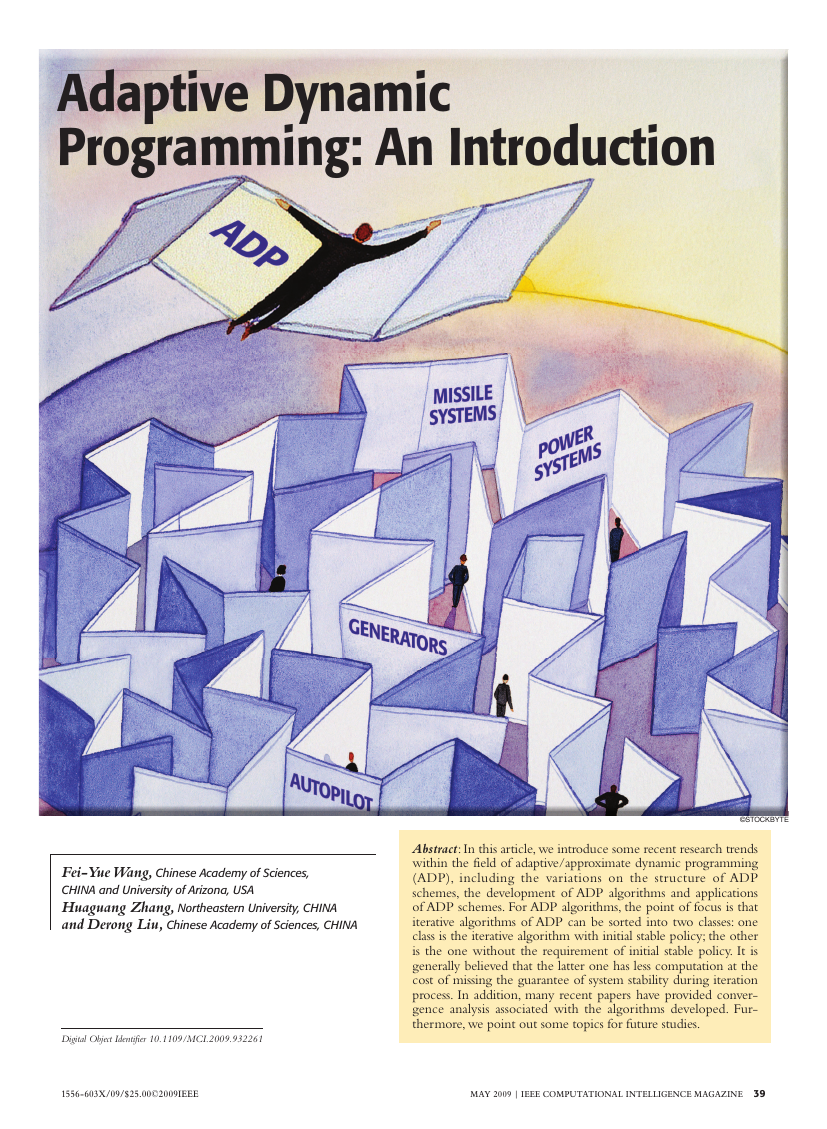
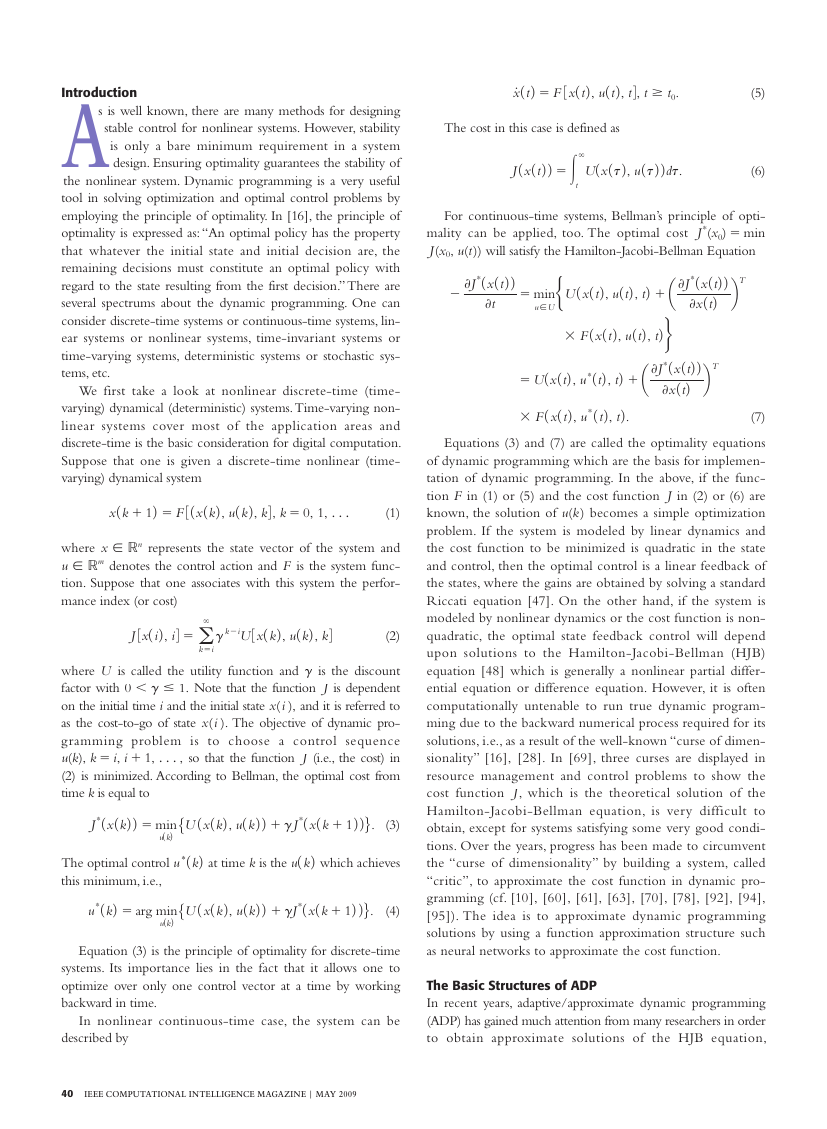
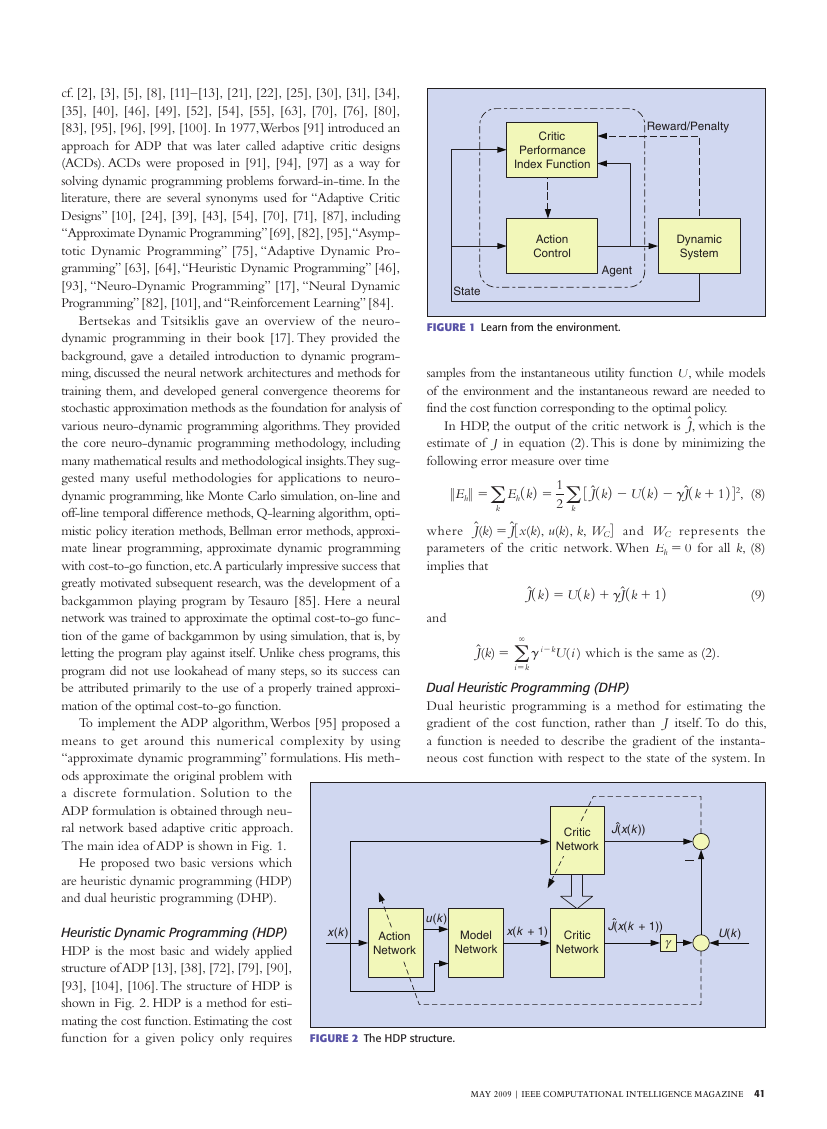
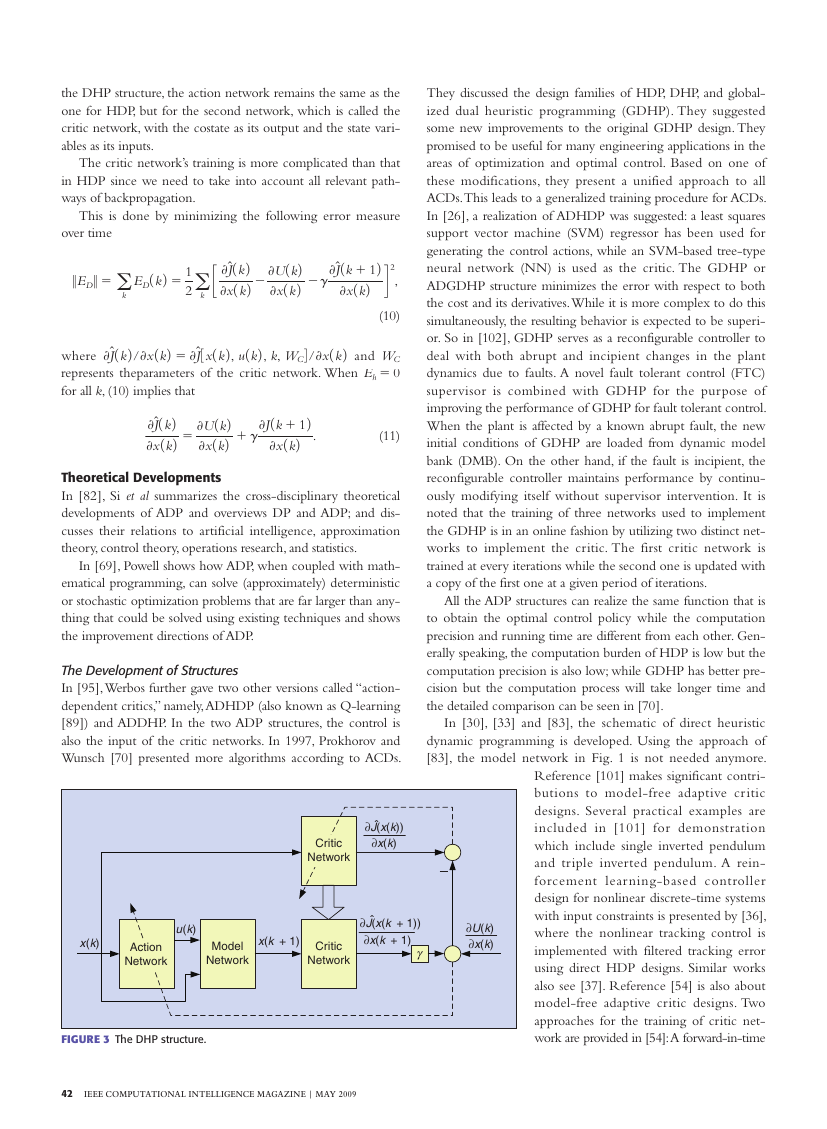
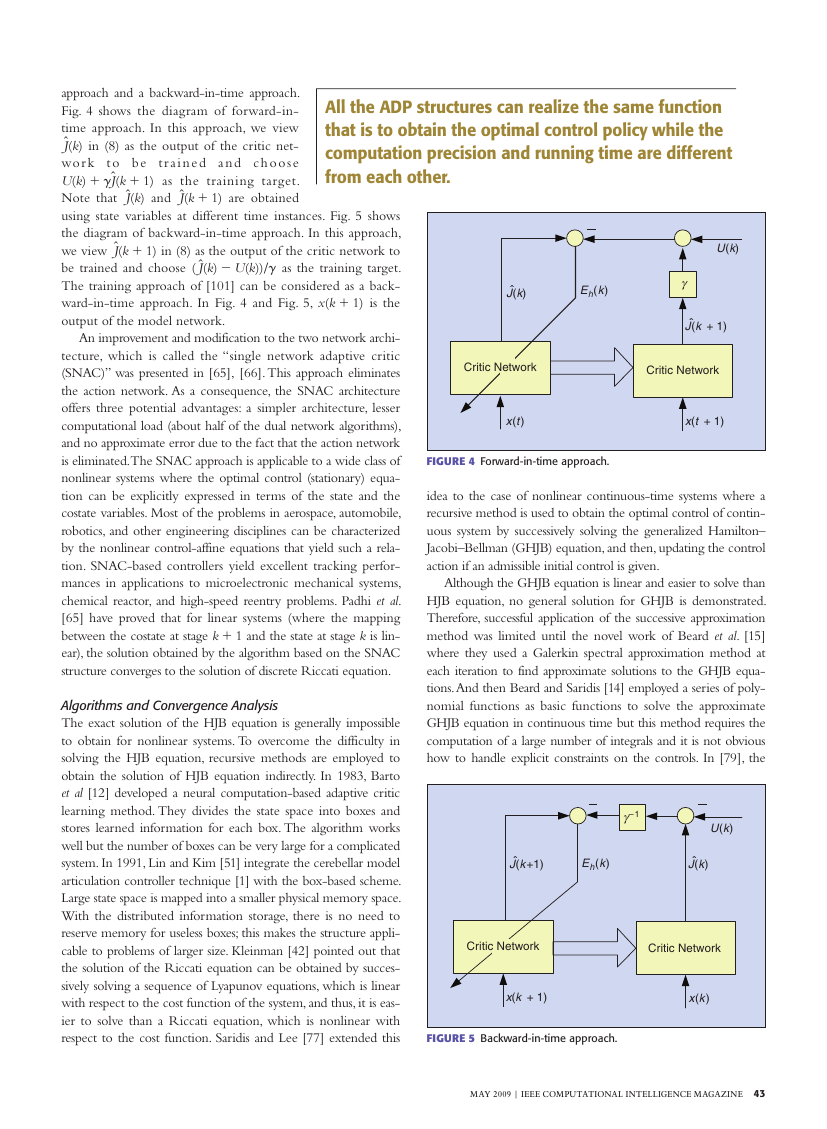
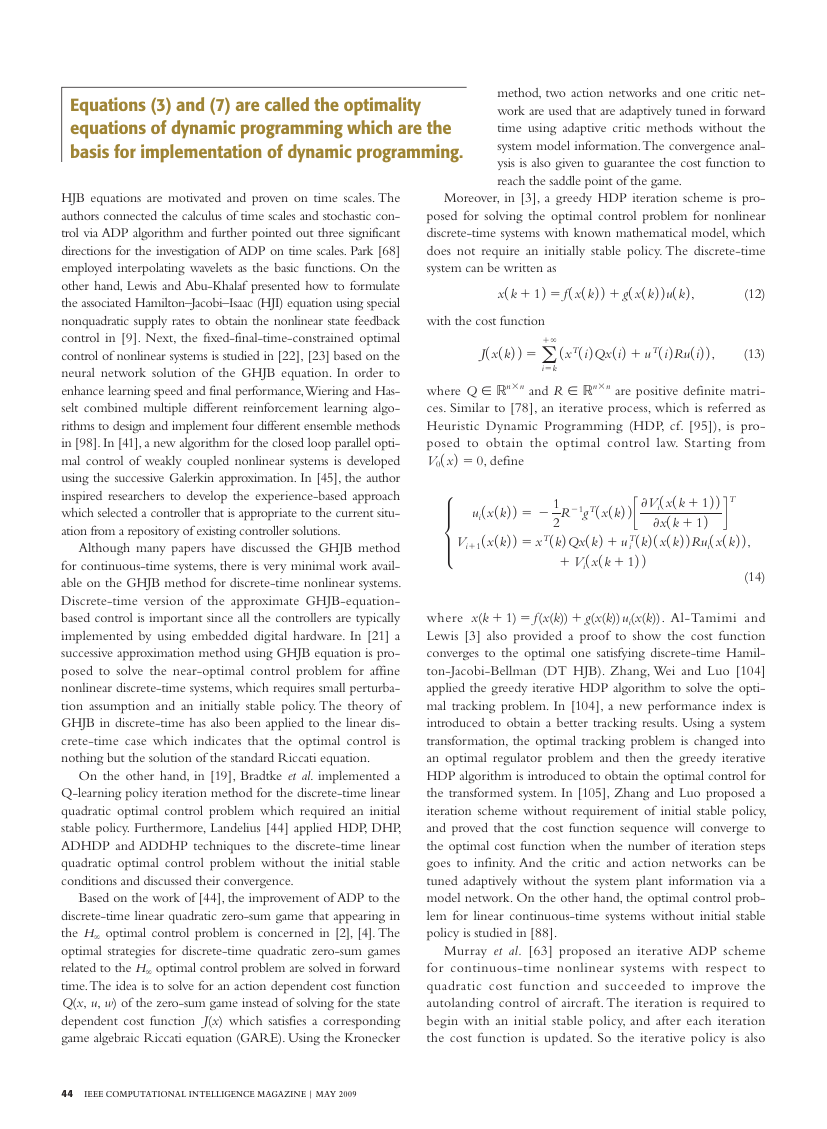
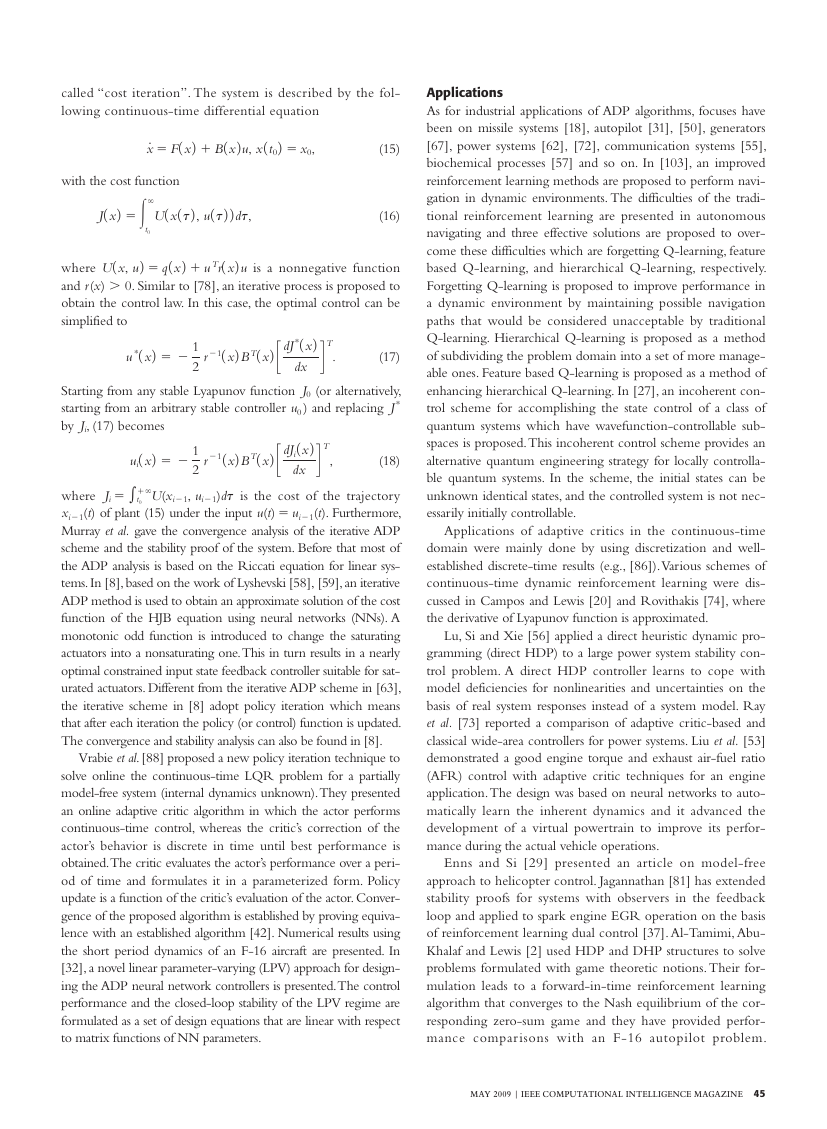









 2023年江西萍乡中考道德与法治真题及答案.doc
2023年江西萍乡中考道德与法治真题及答案.doc 2012年重庆南川中考生物真题及答案.doc
2012年重庆南川中考生物真题及答案.doc 2013年江西师范大学地理学综合及文艺理论基础考研真题.doc
2013年江西师范大学地理学综合及文艺理论基础考研真题.doc 2020年四川甘孜小升初语文真题及答案I卷.doc
2020年四川甘孜小升初语文真题及答案I卷.doc 2020年注册岩土工程师专业基础考试真题及答案.doc
2020年注册岩土工程师专业基础考试真题及答案.doc 2023-2024学年福建省厦门市九年级上学期数学月考试题及答案.doc
2023-2024学年福建省厦门市九年级上学期数学月考试题及答案.doc 2021-2022学年辽宁省沈阳市大东区九年级上学期语文期末试题及答案.doc
2021-2022学年辽宁省沈阳市大东区九年级上学期语文期末试题及答案.doc 2022-2023学年北京东城区初三第一学期物理期末试卷及答案.doc
2022-2023学年北京东城区初三第一学期物理期末试卷及答案.doc 2018上半年江西教师资格初中地理学科知识与教学能力真题及答案.doc
2018上半年江西教师资格初中地理学科知识与教学能力真题及答案.doc 2012年河北国家公务员申论考试真题及答案-省级.doc
2012年河北国家公务员申论考试真题及答案-省级.doc 2020-2021学年江苏省扬州市江都区邵樊片九年级上学期数学第一次质量检测试题及答案.doc
2020-2021学年江苏省扬州市江都区邵樊片九年级上学期数学第一次质量检测试题及答案.doc 2022下半年黑龙江教师资格证中学综合素质真题及答案.doc
2022下半年黑龙江教师资格证中学综合素质真题及答案.doc